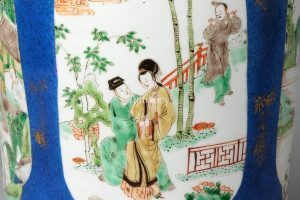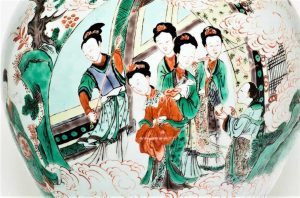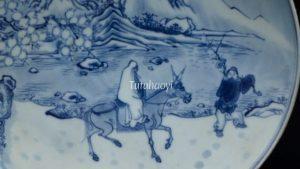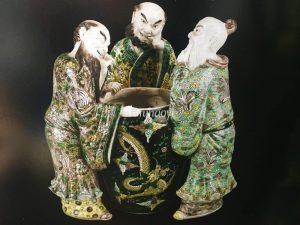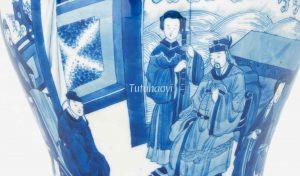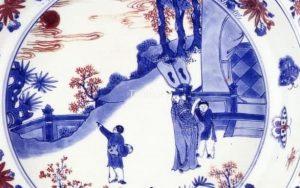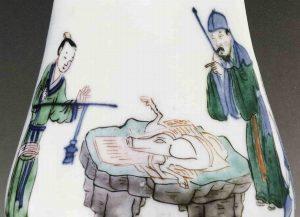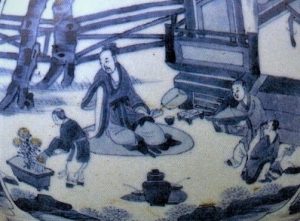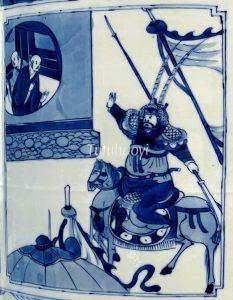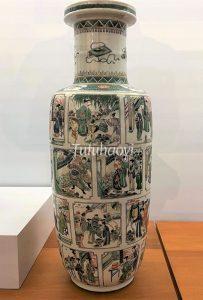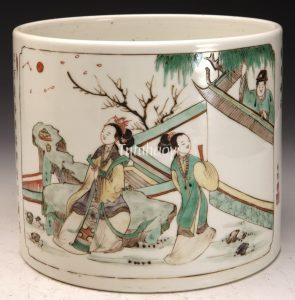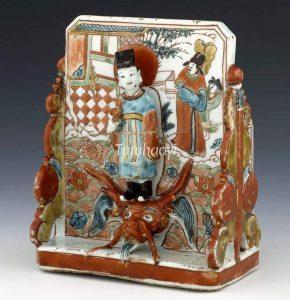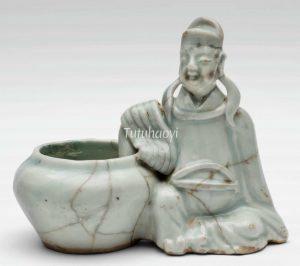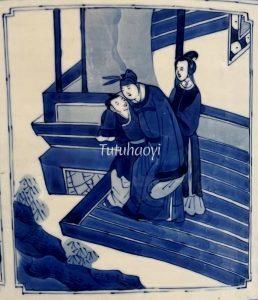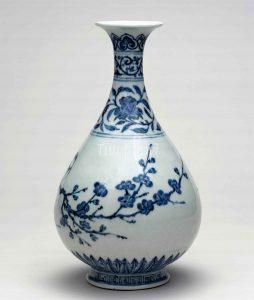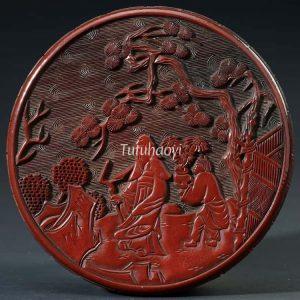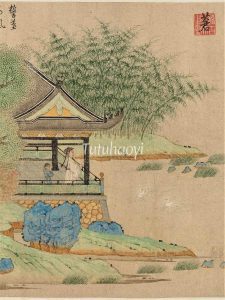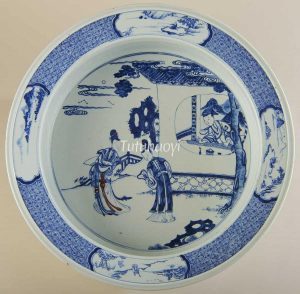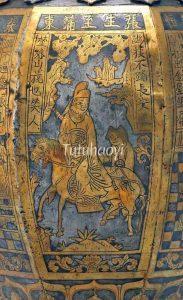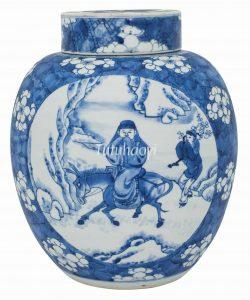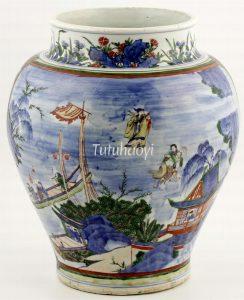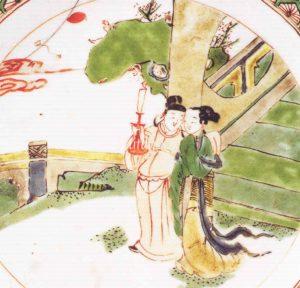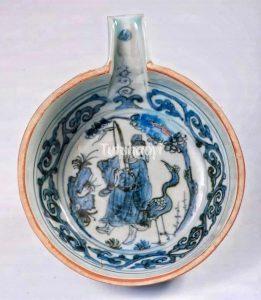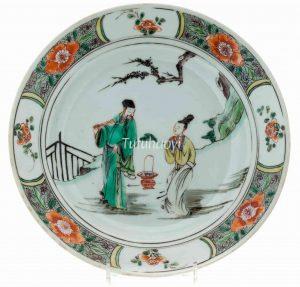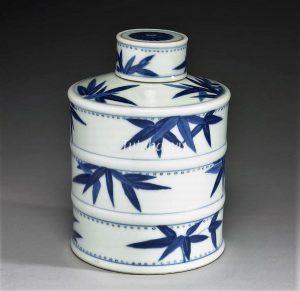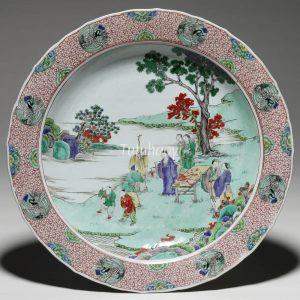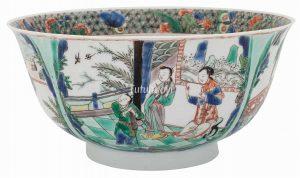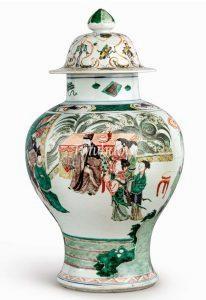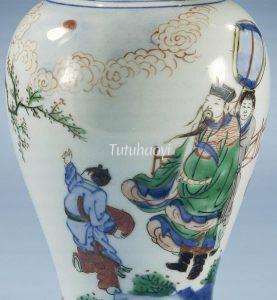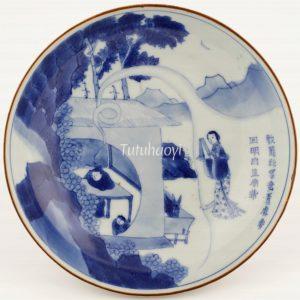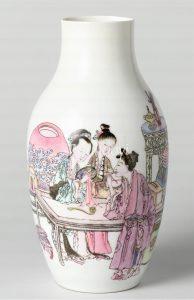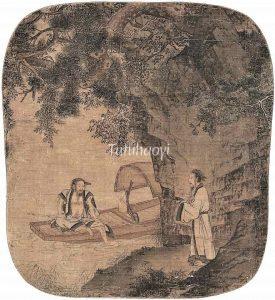Showing Results Containing
Have you ever wondered why the image of the prunus has been a popular motif in Chinese decorative art? Why do Chinese literati love to write poems about plum blossoms and paint them in their art works? Dr Yibin Ni will explain to you the symbolic ...
The story scene comes from a marvel play Legend of the Jade Hairpin, which is not to be confused with the scene in Romance of the Western Chamber. Read the following article to find out details of the story and how this figural scene is depicted.<...
In Chinese culture, the Mid-Autumn Moon Festival is related to the legendary fairy Chang E, the Moon Goddess. We often see a hare, her loyal companion, and an osmanthus tree in the picture with her against a background of the Moon Palace. However,...
A literati theme with the image of a scholar riding in a snowscape with branches of plum blossoms in the vicinity has been very popular in traditional Chinese visual culture and literature. But who is the scholar in the scene? Art historian Dr Yib...
The Peony Pavilion is a famous play written by Tang Xianzu in Ming Dynasty. There are very few figural paintings depicting this play on Kangxi famille verte porcelain. Dr Yibin Ni first identified the figures and the scene on a porcelain dish in t...
There have been a few interesting discussions even guesses on a mysterious scene which depicts mainly three figures surrounding a large bowl. The story scene actually comes from an important anecdote in Song dynasty in China. Let Dr Yibin Ni expla...
Have you ever been puzzled by the description of ‘figural paintings’ for Chinese porcelains listed by various museums and auction catalogues? In fact, many Chinese paintings with figures refer to ancient stories and have meanings behind the scenes...
This blog is modified from Dr Yibin Ni’s research work first published on Antiques and Fine Art Magazine. The purpose is to appreciate how Chinese porcelain painters from ancient times passed on classical stories and illustrated traditional morals...
Have you wondered why the same story scenes were painted differently on Chinese artworks? How was it painted to present women falling in love on Chinese antique porcelains? Read on to see what Dr Yibin Ni has to say with his analysis.
Have you ever seen such an image and wondered why a young man is holding a shoe and kneeling down in front of an old man? Is there any historical event relating to the shoe and such scene? Read on to see how Dr Yibin Ni deciphers the figures and s...
In Chinese porcelain painting, it can be tricky to interpret a round disc in the sky as a sun or a moon. Knowledge of Chinese culture and pun rebuses are the keys to explain the meanings of the motifs and scenes correctly. Here are some examples…<...
What is the value of deciphering pictorial scenes on traditional Chinese artworks? What is the importance in identifying correct figures and story scenes on antiques? Here is the editor’s conversation with Dr Yibin Ni, an internationally ren...
The traditional theme of ‘Chen Ping Dividing Meat’(陈平分肉) is often mistakenly referred to as Chen ‘Selling Meat’ or even ‘Picture of Selling Meat’ in Chinese art reference books, which reduces a historically significant theme to a mere genre painti...
Images of Tao Yuanming Appreciating Chrysanthemums, like many other traditional historical themes, are often mistaken as a mere ‘flowering-picking’ scene, or, worse, simply a ‘figure painting’. Let’s see an example.
This is Scene One of Act Two of the Chinese classic popular drama Romance of the Western Chamber (西厢记 Xixiang Ji), written by the Yuan playwright Wang Shifu (125...
The Chinese classic drama Romance of the Western Chamber (西厢记) depicts a romantic story of a young couple in the Tang dynasty. The name of the play has also been translated into The Story of the Western Wing, The West Chamber, and Romance of the Western Bower, etc. It stands as one of ...
This is Scene Two of Act Two of the Chinese classic popular drama Romance of the Western Chamber (西厢记 Xixiang Ji), written by the Yuan playwright Wang Shifu (1250–1336).
Sun Feihu 孙飞虎, a local bandit, was attracted to Miss Cui Yingying (崔莺莺)’s beauty and wanted to abduct her from the Buddhist monastery wh...
This is from Scene Three of Act Three of the Chinese classic drama Romance of the Western Chamber (西厢记 Xixiang Ji), written by playwright Wang Shifu 王实甫 (1250–1336) in Yuan dynasty. The episode is commonly called Repudiation of the Billet-Doux (赖简).
Zhang Junrui (张君瑞, also called Scholar...
This is from Scene Three of Act One of the Chinese classic popular drama Romance of the Western Chamber (西厢记 Xixiang Ji), written by the Yuan playwright Wang Shi...
During the Tang and Song dynasties, there were large dragon–carp (鳌鱼) reliefs on the steps in front of the imperial palace. In t...
This story scene originates from one of the four famous romantic plays in Yuan dynasty, Pei Shaojun on horseback meeting Li Qianjin over the garden wall (also known as On Horseback and over the Garden Wall) 裴少俊墙头马上, which was written by playwright Bai Pu (白朴 1226 – after 1306).
Pei Shaojun ...
This is Scene Two of Act One of the Chinese classic popular drama Romance of the Western Chamber (西厢记 Xixiang Ji), written by the Yuan playwright Wang Shifu (1250–1336).
After Zhang Gong 张珙 (styled Junrui 君瑞) glimpsed Cui Yingying 崔莺莺 outside the Buddha Hall in the Monastery of Universal Salvation, he wen...
This scene is from one of the most famous Chinese dramatic works, Romance of the Western Chamber 西厢记, which was written by the Yuan playwright Wang Shifu (王实甫 1260–1336). The play tells the story of a secret love affair between Zhang Gong (张珙, also called Scholar Zhang 张生) and Cui Yingying 崔莺莺, the daughter of f...
Li Bai (李白, courtesy name Taibai 太白, 701–762) from Tang dynasty (618–907) was one of the greatest poets in Chinese history. He was also famous for his love of wine and was extremely productive in writing poems while he got tipsy.
Typically, the scene in Fig. 3 depicts one of the Eight Immortals of the Win...
This is Scene Four of Act Two of the Chinese classic popular drama Romance of the Western Chamber (西厢记 Xixiang Ji), written by the Yuan playwright Wang Shifu (1250–1336).
Madame Cui and her daughter Cui Yingying 崔莺莺 were residing temporarily in the monastery where Zhang Junrui’s (张君瑞, also called Scholar ...
The tree commonly referred to in English as the flowering plum in fact belongs to the species Prunus mume, which is part of the apricot family.
With the pine and ba...
‘Li Mi (李密 582–619) Hanging His Books on His Ox Horns’ is one of the inspirational self-improvement stories in ancient China. It was adopted in the famous Three-Character Classic (三字经 San Zi Jing), written in the 13th century. The primer served as children’s first textbook in elementary...
Tao Yuanming (陶渊明, 365–427), also known as Tao Qian 陶潜, the paragon of ‘Fields and Gardens poetry’, spent most of his life as a hermit in a cottage in the countryside, reading, drinking wine, and writing poetry in an unmannered style. He had a unique eye for the beauty and serenity of the natural world c...
Legend of the Jade Hairpin (Yu Zan Ji 玉簪记) is a Ming-dynasty ‘marvel play’ which was the major drama genre of the time. The play, consisting of thirty-three scenes, was written by Gao Lian (高濂 fl. 1573-1581) around 1580 and remained to be a popular classic for the following three hundred years. It is a Shakespea...
Wang Xizhi (王羲之, 303–361) is often said to be the greatest calligrapher in Chinese history. He has his biography in the official history of Jin 晋 dynasty (c. 265–420). One anecdote in it concerns his fame for his calligraphic skill and his love of geese. A Daoist priest in the neighbourhood raised a handsome flock of gee...
This is Scene Five of Act Two of the Chinese classic popular drama Romance of the Western Chamber (西厢记 Xixiang ji).
At a family dinner party, Zhang Junrui’s (张君瑞, also called Scholar Zhang 张生) dream of marrying Yingying (莺莺) the love of his life was shattered by Yingying’s mother because he was a nobody w...
Young scholar Zhang Junrui (张君瑞, also called Zhang Sheng 张生) is the male protagonist in the famous ancient Chinese play, Romance of the Western Chamber (西厢记 Xixiang j...
Meng Haoran (孟浩然, c. 690–740) is one of the most renowned poets in Tang dynasty (618–906). He started off pursuing a civil service career and then abandoned it to concentrate on poetry. He was a major influence on other Tang and later poets because of his innovative focus on nature. There is a play attributed to the note...
‘True love conquers all’ is the theme of the Peony Pavilion (牡丹亭 Mudan Ting), a musical play of fifty-five scenes written by Tang Xianzu (汤显祖, 1550–1616) in Ming...
The Ming-dynasty play The Story of the Blue Robe (青袍记 Qingpao ji, also called《梁氏父子传胪记》) tells the story of how Lv Dongbin (吕洞宾 Lü Dongbin or 吕纯阳),...
Romance of the Western Chamber (西厢记 Xixiang ji) is the most popular love comedy in late imperial China. In the story, Scholar Zhang (张生 Zhang Junrui) falls in love with a beautiful lady named Cui Yingying (崔莺莺), who happens to be stranded in a monastery with her widowed mother and, after plenty of twist...
One day during Su Shi (苏轼, 1037-1101)’s exile in Huangzhou, Hubei province, his friend, Fo Yin (佛印, 1032-98) invited him and Huang Tingjian (黄庭坚, 1045-1105) to taste the ‘Peach-Blossom-Flavoured Vinegar’, made with a famous recipe inherited from the Tang dynasty (618-907). Su Shi, Huang Tingjian, and Fo Yin gathered arou...
Zhao Bian (赵抃, 1008–84) was held in high esteem all his life and posthumously because of his incorruptibility and sound statesmanship during his entire career. His prize possessions were legendarily well-known: a qin zither and two pets, a Continue Reading
Pines, bamboos, and plum blossoms (prunus) form the ‘Three Friends in Winter’ (岁寒三友) motif. The early blossoming plum is the harbinger of spring; the
Qiuhu (秋胡), a native of the state of Lu during the Spring and Autumn period (770-476 BCE), was ordered to take up an official post in the state of Chen a scant five days after his marriage to Jiefu (洁妇), the ‘Loyal Wife’. Five years later, on his way back home, he encountered a woman by the roadside picking mulberry leav...
In the current form of the character 竹 zhu, the image of two bamboo stems side by side is still clear. Other ancient forms of the character show the pair gently bending toward one another, illustrating the flexibility of this highly esteemed plant. ‘Young bamboo bends easily’ is one of the many common sayings that refer ...
‘Sima Xiangru Inscribing on the Bridge Gateway (相如题桥)’ was a popular theme in theatre from at least the Song (960-1279) through to the Qing (1644-1911) dynasty. Sima Xiangru (司马相如) was a Western Han (202 BCE – 8 CE) scholar unsuccessful in making a career in civil services. However, Wang Ji, the magistrate of Linqi...
The osmanthus tree prominent in the Moon Palace came to be a symbol for elite talents in the Jin dynasty 晋朝 (265-420). In around Tang dynasty (618-907), ‘plucking a s...
Young Chen Ping (陈平, ?–178 BCE), later a minister of Western Han dynasty, as being an exemplar of fairness in his everyday work. According to Sima Qian’s (司马迁, 145BCE – ?) famous work Historical Records – Prime Minister Chen’s Family (史记 – 陈丞相世家 ), one day, Chen Ping’s village held a ceremony to offe...
This is a story from the Romance of the Western Chamber, a famous Chinese play written by Wang Shifu (王实甫, 1260-1336) in Yuan dynasty (1271-1368):
On his way to the capital to take civil-service exams, Scholar Zhang (张生) fell in love with the beautiful Cui Yingying (崔莺莺), who was stranded in a monastery. ...
With strategic plans to restore the war-torn country back to order, the talented scholar Li Jing (李靖) was paying a visit to the powerful Lord Yang Su (杨素), who enjoyed luxurious ways of living and female company around him. To Li Jing’s disappointment, Lord Yang did not take his plans seriously. However, Red Fly Whisk (红...
After Zhang Liang (张良, d. 189 BCE) failed to assassinate the first emperor of China, he changed his name and went into hiding. One day, he ran into Lord Yellowstone (黄石公), a guru strategist by the Yi Bridge (圯桥). The old man could see Zhang’s great potential but he wanted to put him through a series of tests before takin...
The action of ‘pointing to the sun’ is termed in Chinese as ‘指日 zhi ri’, which sounds and looks exactly the same as (both homophone and homograph of) the phrase ‘指日 zhi ri’ meaning ‘in a few days’ time’. The state of ‘something rising high up’ is ‘高升 gao sheng’ in Chinese, which may be metaphor...
A scholar official in Song dynasty Sima You (司马槱) dreamed of a beautiful girl presenting him the first half of a song, which he later developed into a full version called Huangjinlv (黄金缕). The girl was none other than a famous courtesan Su Xiaoxiao (苏小小) who lived by the Qiantang River and was in the local high ...
Lotus flower is one of the most commonly seen motifs in Chinese traditional artworks. It is particularly favoured by scholars because one of its biological characteristics is that it grows out of mud yet blooms pure and untainted flowers, which scholars refer to their own uncorrupted nature.
Lotus in Chinese can b...
Zhang Chang (张敞, ?- 48 BCE) and his wife grew up in the same village. When they were both children, Zhang Chang once threw a pebble at his future wife and, unfortunately, the scratch left a scar on one of her eyebrows. Later, Zhang became a civil servant and learned that the girl he once hit with a pebble was unmarried b...
These set of images portray the last moment of the life of Qu Yuan 屈原 (340-278 BCE), an important Chinese poet and politician, who was in exile in the wilderness because of his unsuitable political stance in court. He was talking with a fisherman on the bank of the Miluo River (汨罗江) in Hunan province before he threw hims...

